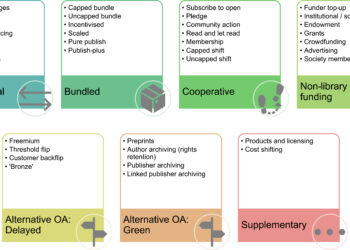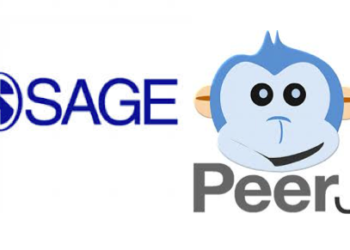It’s largely not appreciated outside the publishing industry that publishing is mostly a virtual affair. While publishers differ considerably on what they control directly and what they push out to vendors (and, for that matter, to distributors), the impulse is always to outsource. Thus few publishers nowadays own printing presses (newspapers are a key exception) and a great deal of content management and Web hosting is handled by third parties, something that is almost entirely invisible to end-users. Perhaps better known is the fact that publishers are rarely authors–though even here there are exceptions as in the case of legal reference publishers and the “managed texts” of the K-12 market. For the most part publishers sit in the middle of the value chain, investing in intellectual property (with editorial decisions driving the investment) on one side, and passing off the enhanced content to a network of downstream distribution partners, whose task it is to work directly with end-users. The instinct to outsource leads publishers on a quest to improve their networks both upstream and down. Who is that perfect vendor who will reduce costs, invest in new features and capabilities, be utterly reliable, anticipate swings in the marketplace, and solve all of a publisher’s problems–except the core one, of course, which is to determine what to publish?

As Kitchen readers know, I have been working on a direct-to-consumer (D2C) research project for the university press community for some time, and the question of finding good vendors has come up again and again. It’s a tough question, and the reason for that is there is no perfect vendor. There are good, even excellent, vendors, but no one that is perfect. For university presses this presents problems with building an effective D2C program, as the vendor ecosystem has not yet fully matured.
Before I say another word, I want to emphasize that some of the current vendors are simply outstanding. I am not going to name names here, but the range of services available is truly impressive. A university press can now find multiple vendors that can handle warehousing and distribution for print books; digital asset distribution; white-label ebook reading apps; promotional services optimized for the social media stream; full ecommerce capability (often called simply “a shopping cart”); metadata management, including the distribution of ONIX feeds; search-engine optimization; file conversion; DRM if desired; and on and on. So how is it that all of these very good and even excellent vendors are somehow less than perfect? The answer lies in the actual circumstances of most university presses, which typically are small operations. This is a matter of perspective, but I would say that outside Oxford University Press and Cambridge University Press, all university presses are small organizations. Yes, there is a sharp difference between the small and the tiny, but organizational resources rarely rise to the level that can take advantage of the full breadth of technological and marketplace opportunities.
Consider a university press with sales in the range of $5 million a year. This press wishes to sell books directly from its Web site. In order to do so, it must obtain in some way all of the features mentioned above and more. So a secure shopping cart is identified, which must be linked to the press’s distribution system. Who will do that work for the press? The press wishes to sell ebooks from its own site, but how to host the content? If the press is to negotiate with a DAD (digital asset distributor), who is equipped to handle the contract negotiations? And how is the hosted digital content integrated into the consumer-facing Web site and the “back end” for distribution and billing? After a digital file is shipped, who handles customer service? How is a press to enable a reader to view a book on, say, a smartphone or iPad? Well, that is indeed a complicated question. Is the ebook copy-protected? If it is (most presses copy-protect their ebooks), then the press will have to obtain the rights to ereading apps that support copy-protection. That’s another agreement to negotiate and another piece of technology to integrate into the overall system. If you want to put the covers of your books onto Pinterest and enable a reader to click on a title and then immediately be presented with an option to purchase, that’s yet another bit of technology to understand and implement–and another contract to negotiate. Now imagine what it would take to work through all of these items for a press with sales of $1 million.
What most presses need is the ability to have all these services provided for them in such a way as to make the prospect of initiating such a service quick and painless. And that’s why there are no perfect vendors. Vendors provide technology, but presses are looking for solutions.
The problem is scale. University presses–indeed, all publishers–would be happy to provide all these services for themselves, happily integrating new technology when it comes along, if only they could. That requires a staff to analyze opportunities and the ability either to perform systems integration or to know how to procure and manage it. The absence of such a staff naturally leads small presses to look for larger partners, some of which may be university presses themselves. From an organizational point of view, the diversity of the university press world (there are 134 members of the AAUP) is deceptive, as many of a press’s functions are provided by other presses or organizations. The exception is always editorial. When you outsource that, what do you have left?
What would a perfect vendor look like? Putting aside the obvious point that such a vendor must deliver high-quality service at a reasonable price, such a vendor would respect a client press’s editorial identity, but do just about everything else. An individual press would continue to develop and implement its own acquisitions strategy, using its own staff and faculty advisors, but once a manuscript comes in and is declared to be in final condition, the press would begin a series of hand-offs. The first one is for copy-editing. The press would provide a final manuscript in Microsoft Word (yes, complain all you want about the horrors of Word, but it is a standard and is likely to remain so for many years to come) to a fully integrated vendor, who would oversee copy-editing and return the manuscript to the press and author for final review. The vendor would then place the book into production, providing graphics where required and outputting the necessary file formats. Such files would be used for any and all commercial venues (for print, for ebooks to be sold from the press’s own site, to send to Amazon and other vendors, etc.). The vendor would take on the bulk of sales and marketing responsibility, with the press maintaining control of local areas and some aspects of demand-creation (e.g., PR). The vendor would also handle returns for physical books and customer service for everything.
If the press seeks to sell these books from its own Web site, that site can and should be hosted by the vendor, though the branding would be that of the individual press. The vendor would provide metadata management tools, ecommerce capabilities, and everything else. The vendor would also provide services that are provided by yet another group of subcontractors: white-label ereading apps, for example, or a digital manuscript submission system.
Now, if some of this sounds familiar, that’s because you may know vendors–good but not perfect vendors–that provide many of these services. Or you simply may be familiar with journals publishing, where most of this is in place. As I’ve noted before, the trend in the journals world is for small publishers to forge relationships with larger publishers, who in turn provide just about every service for the small publishers–from manuscript submission systems to production to sales and marketing, etc.–everything, that is, except for the editorial function. OUP and Wiley are thus solutions providers for such clients as ESA and AGU respectively. We don’t have the full equivalent in the book world, at least not yet.
The emergence of the perfect, the comprehensive vendor could change the book publishing landscape, much as it has in journals. In the journals world the full-service larger publishers (Elsevier, Cambridge, Sage, etc.) have changed the nature of selling materials to academic libraries, focusing primarily on large collections and often working directly with library consortia. This has the practical if unintended effect of squeezing out the smaller publishers that have not forged partnerships with one of the bigger players–and those smaller publishers may thus feel compelled to make just such an arrangement, adding one more spin to the cycle. A perfect vendor in the book world may have a comparable impact on the overall marketplace, altering the landscape to the advantage of its clients and at the expense of others. Consider, if you will, what it would mean to have 20 or 30 academic book publishers all participate in the creation and exploitation of a common customer database. Drafting the privacy and use policy for such a program would be daunting, but the outcome of such an effort could be a vastly more potent marketing platform.
The perfect vendor could alter the landscape in another intriguing way as well by making it easy for institutions that do not currently have book programs to get into the business. If a university without a press were to decide now that it should get into the publishing game, where would it start? Would it build a warehouse? How many people would it hire? How would it handle file conversions and production? Where would it go for a fulfillment system? I hope never to have to persuade a university administration to create a new press from scratch. (On the other hand, people who have no idea of just what it is that book publishers do might leap at the opportunity.) If there were a comprehensive vendor around, however, this is an easy conversation. “Recruit a good experienced editor, and then let’s see what happens. If everything goes wrong, this is what it will cost you over 3 years.” That’s an easier program to sell.
To put this another way, and to invoke some buzzwords from the business world, a comprehensive vendor would be a disruptive business innovation. It’s disruptive because it would create a new class of customers, institutions that do not yet have a book publishing arm. That means more competition for good authors, more reasons to develop a differentiating strategy. And that’s the real reason to look for, hope for the comprehensive, the perfect vendor to emerge, not simply to reduce costs through outsourcing but to invite new participants into the marketplace, where they will try out new ideas, make some mistakes, but generally rattle the cage. If there are any vendors out there that want to take on this task, please raise your hands.
Discussion
7 Thoughts on "The Quest for the Perfect Vendor"
What Joe describes here is exactly the situation of the University of Rochester Press, whose only employee is a director/editor. Every other function is outsourced to the British academic publisher Boydell & Brewer, and the arrangement seems to have been working very well. (I acquire books in political theory part-time for URP.) His description also applies to the model that the CIC (Big Ten + Chicago) provosts once proposed circa 2000, viz., having the presses in this consortium maintain editorial offices only while all other functions would be handled by one entity (presumably Chicago, which has its distribution center already serving most of the other CIC presses). If such a plan had gone forward, the CIC would now be in a position to allow the University of Maryland, its newest member, to start a press at minimal cost. (I was director at Penn State when this plan was being discussed.)
Is there anything publicly available or shareable about the CIC proposal and why it ultimately was not adopted?
There is this report: http://www.cic.net/docs/default-source/reports/acup_final_report_main.pdf?sfvrsn=0. My hypothesis as to why the proposal failed was that many of the provosts who were interested in it retired or moved to new jobs, and in the face of resistance from some press directors, there failed to be any follow-through after this report.
Ben Franklin wrote for his own printing press, but not everyone can aspire to be Ben Franklin. Academic publishers have offered their services to learned associations for quite a long time. In the early 1890s, the British Macmillan published Physical Review, started by a group at Cornell. The American Physical Society was not organized for a decade. As business becomes more complex (as does the world of knowledge) than it was more than 100 years ago, no one can put their fingerprints on every piece and process without courting catastrophic failures. The real question is whether a vendor can be trusted.
When thinking about a perfect vendor, one of my biggest concerns is loss of control, primarily because of the power that such a vendor might wield. There is a player out there that does handle physical distribution, offers DAD services, is a major POD printer, offers e-commerce, and is developing an integrated database solution for publishers that seamlessly ties into those services . It’s a great company with competitive pricing and excellent service, but it’s also growing so fast (partly by buying its competition) that it may soon find itself with little if any competition for many of those services, which is both their goal and my concern. Once they are the only vendor in town, what happens to that great pricing and excellent customer service? Isn’t moving to such a vendor something of a marriage without an option for divorce?
Rather than always looking outside for outsourcing, I sometimes wonder if it wouldn’t make sense for the larger institution to look internally for cooperative alternatives. An example of this might be the decision of Indiana University to move Indiana University Press’s Editorial Design and Production out of the press and establish it as an independent service available to all of the University’s constituencies. Here at Penn State we have a Department of Agriculture cooperative extension office that distributes over a million pieces of literature every year. Why didn’t the university consider combining their distribution with the Press’s distribution, the print distribution done by World Campus, and the distribution done by a number of other internal entities, rather than just outsourcing that extension distribution? How hard would it be to tweak an institutional repository so that it could also function as a DAD? Isn’t it already a digital asset distribution system? It seems there are ways of reducing costs that don’t require losing control, and which don’t result in building monopolies that we will someday be at the mercy of, if only outsourcing weren’t such a popular religion.
Of course the CIC proposal was not outsourcing in the sense of loss of control. The CIC consortium itself would have full control of such a combined operation.



